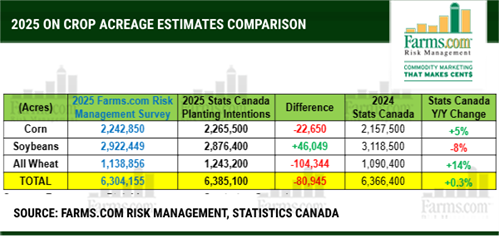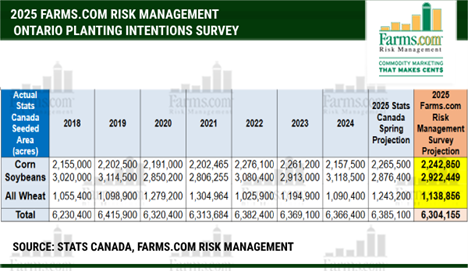Soybeans
While overall acres of soybeans are projected to decline, some regions will see more soybeans planted, particularly in Central Ontario. Economics and lower soybean prices are expected to push more farmers towards corn rather than soybeans.
The survey predicts a small decline of 1.86% is expected due to lower premiums.
Wheat
Wheat acreage will be up by 4.4% from 2024. The increase is attributed to favorable weather last fall, allowing more wheat to be planted, although wheat prices remain challenging. However, wheat acreage is still expected to be down compared to the 5-year average.
There are significant decreases in specific types of wheat, such as Hard Red Spring (down 57%), Soft White Winter (down 17.8%), and Hard Red Winter (down 9.7%). However, Soft Red Winter wheat is expected to increase by 15%.
Canola
The survey suggests canola acres being down 7% Y/Y in Ontario, which has a very small acreage in comparison to what Western Canada grows.

Regional Variations:
Every region is different of course, and has its own mix.
- Southwestern Ontario: More corn and wheat acreage expected, less soybeans.
- Western Ontario: A shift from soybeans to wheat.
- Central Ontario: More soybeans and wheat, stable corn acreage.
- Eastern Ontario: More corn, fewer soybeans, and more wheat.
- Northern Ontario: Expected decline in all crops, though survey data from this area is light.
Stephen Denys, Director of Business Management at Maizex Seeds, agrees that it may not be an early planting season and if it turns wet, the heavy clay regions in Ontario will switch to more soybean acres and the month of May looks to be wet.
“The average planting time in Ontario is from the end-of-April to the first half of May. Worries over U.S. tariffs and higher input costs for corn could cap corn acres in 2025,” underlines Denys.
Lower premiums on IP soybeans vs. last year and growing concerns over higher input costs for corn may lead to farmers switching to more soybean acres by the time the 2025 planting season is over according to Maizex Seeds Chief Agronomist Henry Prinzen.
Agostino says some farmers may be doing a poor job of managing their input risk. Farmers could have booked 28% less in nitrogen costs last fall at $350 - $360/ton vs. today at $500 - $540/ton today. And as of April 3, 2025, they will likely be hit with a US tariff.
“The Risk Management Planting Intentions Survey is spot on with total wheat acres in Ontario,” says Peter Johnson, known as Wheat Pete. Hey says they survey numbers are similar to the Agricorp numbers at around 1.1 million acres, and the wheat crop looks good and big, especially in Lambton County.
Johnson notes there are some problems areas. Wheat in the North is damaged by snow mold and the rye crop has been some of the worst he has seen in many years.
“Parts of Essex County have also been hit with water damage in the form of snow rot, but it could still recover but remains questionable. The further North you travel, the more snow rot you find.”

Challenges & Concerns:
- Input Costs: Higher input costs for corn, particularly nitrogen, are a significant concern for farmers, potentially limiting the increase in corn acreage.
- U.S. Trade and Tariffs: Ongoing concerns about tariffs and the U.S. global trade situation could affect farmers’ planting decisions and crop pricing. US Tariffs on Canada are expected to be announced today.
- Weather: A wet start to the planting season could shift some acreage toward soybeans, especially in regions with heavier clay soils.
Overall, Ontario’s 2025 planting intentions reflect shifting dynamics in crop choices due to economic factors, weather patterns, and trade concerns. Corn and wheat are likely to see a boost in acreage, while soybean planting is projected to decrease in some areas.
For daily information and updates on agriculture commodity marketing and price risk management for North American farmers, producers, and agribusiness visit the Farms.com Risk Management Website to subscribe to the program.